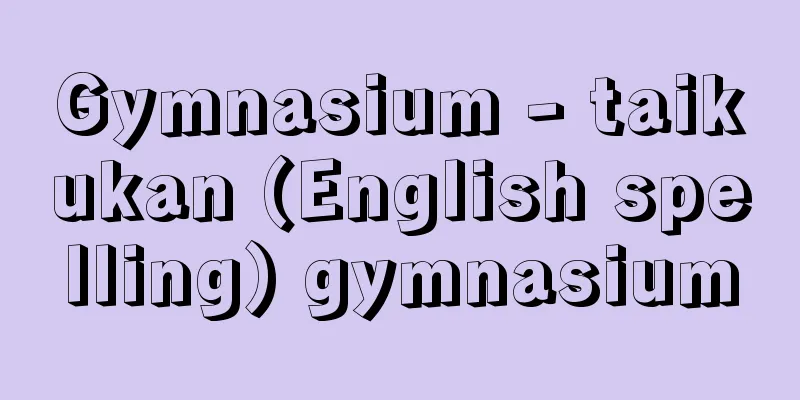Gymnasium - taikukan (English spelling) gymnasium

|
A facility established for the purpose of carrying out physical education and sports indoors. It generally refers to a multi-purpose indoor sports facility with a floor, and those equipped with an indoor pool, martial arts hall, or archery range are called general gymnasiums or sports centers. A gymnasium is broadly composed of three elements: the athletic department, the administrative department, and the spectator department. The athletic department consists of the areas for physical education and sports activities, such as gymnasiums, changing rooms, and shower rooms, and their auxiliary rooms. The administrative department has the function of managing and operating the entire facility and providing services, while the spectator department is, so to speak, a place to enjoy watching sports, and its size varies depending on the gymnasium, but some gymnasiums do not have one. In terms of classification, their characteristics are also diverse, such as gymnasiums for school education, public gymnasiums used widely by the general public, those for specific groups such as private company facilities, and those for profit-making purposes. Historically, the ancient Greek gymnasium and palaistra are considered to be the prototypes of gymnastics. The former was a large public facility on the outskirts of a city, equipped with two indoor and outdoor racetracks, changing rooms, and a bathing area. People gathered there to watch competitions and practice under coaches. The latter had a courtyard for wrestling and other martial arts, and surrounding it were changing rooms, a water bath, a club room, and a room for applying olive oil to the body. However, it was in modern times that the technical content of the facilities was developed. It developed mainly in northern Europe, such as Denmark and Sweden, where physical education was popular and the climate was not favorable, and in Germany. In Denmark, Nachtegaal established a national physical education system, and physical education facilities were also provided. In Germany, F. L. Jahn established a gymnastics center in Hasenheide in 1811, and in Sweden, the Royal Athletic School was founded in 1814 at the suggestion of P. H. Ring. When sports such as ball games were not yet developed, gymnasiums were gymnastic halls, and the facilities inside were mainly for gymnastics, so they were not very large. At the end of the 19th century, when basketball and volleyball were invented and became popular, mainly in the United States, gymnasiums were equipped with the size and ceiling height required for the courts required for these sports, and improvements were made to the floors and lighting equipment. In Japan, with the promulgation of the school system in 1872 (Meiji 5), gymnastics (called taijutsu at the time) was included in the elementary school curriculum for the first time. Since then, school physical education has gradually been positioned as a part of the curriculum, and physical education facilities have been developed accordingly, but most of them were auditoriums that also served as rainy weather gymnastic halls (indoor gymnastic halls). Meanwhile, the Tokyo YMCA gymnasium was completed in Mitoshiro-cho, Kanda, Tokyo in 1917 (Taisho 6), and the National Gymnasium was built in Hitotsubashi, Kanda by the Ministry of Education in 1937 (Showa 12), marking the beginning of the development of public sports facilities. However, it was after World War II that gymnasiums began to improve in both quantity and quality, driven by the spread of sports and competitions such as the National Athletic Meet and the Tokyo Olympics. In addition, the government subsidy policy for public gymnasiums, as enacted in 1961 (Showa 36), is also thought to have contributed greatly. With regard to the nature of today's gymnasiums, which have developed in this way, consideration of use by the elderly and disabled, and energy conservation measures remain issues to be addressed in the future. As a method of facility development, a policy of opening schools to the public during extracurricular activities and on holidays to promote efficient use has been proposed and implemented. Also, mainly in urban areas, methods of multi-layering facilities to make effective use of land, and construction plans that combine school gymnasiums with community gymnasiums, are thought to be one solution to the difficulty of securing land. In recent years, comprehensive facilities that can accommodate a wide range of cultural activities, including sports, education, and the arts, have also begun to appear. [Katsuhiko Nakayama and Junichi Taniguchi] Source: Shogakukan Encyclopedia Nipponica About Encyclopedia Nipponica Information | Legend |
|
屋内で体育・スポーツを行う目的で設けられた施設のこと。一般には床(ゆか)のある多目的の屋内体育施設をさす場合が多く、屋内プールや武道場、弓道場などを備えたものは総合体育館、あるいはスポーツセンターなどとよばれる。体育館は、大きくは競技部門、管理部門、観覧部門の三つの要素から構成される。競技部門は、体育室や更衣室、シャワー室など、体育・スポーツの活動の場とその付属室とからなる。管理部門は、施設全体の管理運営やサービスの機能をもち、観覧部門は、いわばスポーツを見て楽しむ場であり、体育館によってその規模はさまざまであるが、ない場合もある。分類上は、学校教育のための体育館、社会一般に広く利用される公共の体育館、民間企業の施設のような特定者を対象としたもの、あるいは営利目的のものなどその性格も多様である。 歴史的にみると、古代ギリシアのギムナシオンgymnasionやパライストラpalaistraが、その原型と考えられている。前者は、都市の郊外に屋外と屋内の二つの競走路や脱衣室、水浴場などを備えた、規模の大きな公共施設である。そこに人々が集まり、競技を観覧したり、コーチのもとに練習を行ったりしたといわれる。後者は、中庭がレスリングなどの格技の練習場であり、そこを囲んで脱衣室や水浴室、クラブ室、オリーブ油を身体に塗るための部屋などが設けられていた。しかし、施設の技術的な内容が整ってくるのは近代においてである。それは体育が盛んで、気候条件に恵まれないデンマーク、スウェーデンなど北ヨーロッパやドイツを中心として発達してきた。デンマークでは、ナハテガルが国民体育の制度を確立し、体育施設も備わってきた。ドイツでは、F・L・ヤーンが1811年にハーゼンハイデに体操場を設置し、スウェーデンでは、P・H・リングの提唱により14年、王立体育学校が設立された。ボールゲームなどのスポーツがまだ発達していなかったころは、体育館は体操場であり、内部の設備も体操を中心としたもので、面積もあまり広くはなかった。19世紀の終わりにバスケットボールやバレーボールの競技が考案され、アメリカを中心として盛んになるにしたがって、これらの競技に必要なコートを基準とした広さや、天井の高さが備わり、床の改良や照明設備のくふうなども施されてきた。 日本においては、1872年(明治5)の学制の公布により、小学校の教科に初めて体操(当時は体術)が取り上げられて以来、しだいに学校体育が位置づけられ、それにあわせて体育施設も整備されていったが、多くは講堂兼雨天体操場(屋内体操場)といったものであった。一方、1917年(大正6)に、東京・神田美土代(みとしろ)町に東京YMCAの体育館が完成し、37年(昭和12)には、文部省によって神田一ツ橋に国民体育館が建設されるに及んで、社会体育施設の萌芽(ほうが)期を迎えた。しかし、体育館が充実してくるのは第二次世界大戦後のことで、スポーツの普及や、国民体育大会、さらに東京オリンピックなどの競技会が契機ともなって、量的にも質的にも整備されてきた。加えて、1961年(昭和36)に制定されたスポーツ振興法による、公共体育館への国庫補助政策の貢献も大きいと考えられる。このように発展してきた今日の体育館のあり方に関して、高齢者や身障者の利用に対する考慮や、省エネルギー対策などが、今後も課題としてあげられる。そして施設整備の方法として、課外や休日に一般に開放して効率的利用を図る学校開放の方策が提唱され、実施されてきている。また都市部を中心として、土地の有効的利用から施設を重層化する方法や、学校体育館と社会体育館とを一体とした施設計画などは、土地確保の困難さに対応していくための解決策の一つと考えられる。近年、スポーツをはじめ、教育、芸術などの多目的な文化活動のできる総合的な施設もみられるようになってきた。 [中山克彦・谷口純市] 出典 小学館 日本大百科全書(ニッポニカ)日本大百科全書(ニッポニカ)について 情報 | 凡例 |
<<: International Charter of Physical Education and Sport
Recommend
calabash-curare (English spelling) calabashcurare
…Other plant species, such as Chondrodendron , Ab...
A Psalm of Life
He later became a professor of modern languages ...
Curandero (English spelling) [Spain]
A Latin American indigenous witch doctor. The caus...
Eigenshipa - Eigenshipa
…Shogun Yoshimitsu made Eigen-ji a place of praye...
Contagious bovine pleuropneumonia
Contagious pneumonia of cattle. Legally-designated...
Miknas (English spelling)
...Population: 401,000 (1993). Arabic: Miknās. Lo...
Yasu [town] - Yasu
A former town in Asakura County, central Fukuoka P...
Truvor
…They were called Varyagi, or “Rus Beyond the Sea...
Ohm's law - Ohm's law
This law states that there is a proportional rela...
Asaka Tandomari - Asaka Protein
Year of death: December 10, 2nd year of Genbun (Ja...
Tricyrtis affinis (English name) Tricyrtis affinis
…[Hiroshi Takahashi]. … *Some of the terminology ...
Philoxenos
…In ancient Egypt, the murals of the 19th Dynasty...
Limited Partnership Company
It is a dual-organization company consisting of d...
Teletex
...However, the demand for telex is still on the ...
Saint-Denis (English spelling)
An industrial city in the Seine-Saint-Denis depart...









